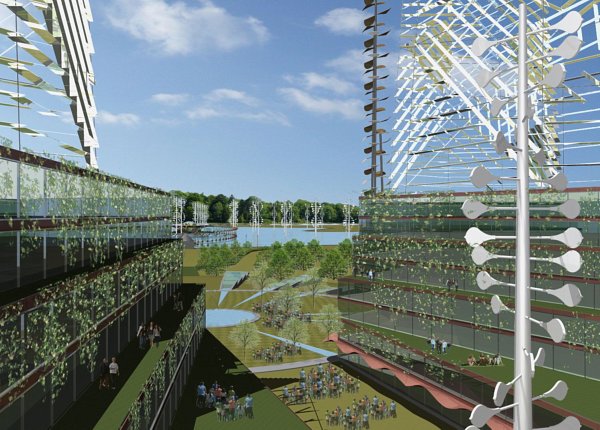
My article on the Norfolk Botanical Garden made the cover of the Summer 2010 issue, with Simon Dorrell's evocative drawing of this detail of 'Breaking Ground', a bronze statue celebrating the Garden's origins as a WPA project in 1938. 200 African-American women and 25 men cleared 25 acres of swamp and planted 4,000 azaleas, 3,000 rhododendrons and camellias, and a hundred bushels of daffodills.

When I met the last surviving WPA gardener Mary Elizabeth Ferguson, shown here in the new WPA Memorial Garden, she recalled the physical hardships they endured -- some gardeners walked five miles before dawn and worked until dusk, clearing trees, pulling roots, removing stumps, and hauling by hand 150 truckloads of soil to build a levee for Mirror Lake, centerpiece of the azalea plantings. For 25 cents an hour, they persevered through the more trying aspects of Tidewater Virginia, covering themselves in camphorated oil to repel hordes of mosquitoes, wrapping their hands with rags on days when you had to chop ice before working the soil, and even using their garden tools as weapons against the native cottonmouth water moccasin, the world’s only semi-aquatic viper. And as this photograph documents, these ladies did all of this and more in skirts, bringing to mind the old quip that Ginger Rogers did everything that Fred Astaire did, but backwards and in heels (photo courtesy of the Norfolk Public Library).
What a legacy they have left us! Most WPA gardens have been lost, including the only other Virginia project, a Wildflower Sanctuary in Petersburg, overgrown when city fathers closed the park rather than integrate in 1954. But the Azalea Gardens survived and thrived -- click on http://www.norfolkbotanicalgarden.org/ and sample the 155 acres of over 30 richly planted themed gardens that offer something to satisfy every horticultural passion in every month of the year.
Here are some of the beautiful plants I saw in the month of December --
Three acres of garden rooms displaying 121 varieties of hollies, like this native Ilex opaca 'Canary' whose golden berries I particularly covet...
...over 1100 types of camellias, like this Camellia sasanqua, to be followed up by the peony-like Camellia japonica, whose golden boss of stamens light up January and February -- remind me why I live in New England?!
And this peaceful "hill and pond" style Japanese garden, a haven of water, stone, and foliage -- I love this cloud-pruned Virginia native, Ilex vomitoria (Yaupon holly), glimpsed through the sinuous tangle of Japanese maple branches.
If your garden can't accomodate 400-foot-long double borders like those in the glorious Statuary Vista, where the silky petals of Magnolia x soulangiana (saucer magnolia) shine against the clipped hedges of lustrous dark green Osmanthus heterophyllus (holly tea olive), then check out the Circle Garden's imaginative container plantings fit for the smallest terrace, clustering at the foot of this hut decked in a green roof of sedum and sempervirens.
And don't miss my favorite plant of all, the graceful Lagerstroemia indica (common crape myrtle). I can do without its overpowering summer blooms -- it's their shapely form and exfoliating bark, revealing smooth dapples of warm brown and gray, that captivate me -- as an expressive specimen...

In the warmer months you can put your face to the sun among 3,000 rose bushes, a Butterfly Maze that hosts beauties like the Painted Lady and Gulf Fritillary, and the Four Seasons Meadow, where grasses like the lavendar knee-high haze of Muhlenbergia capillaris (pink muhlygrass) demonstrate alternatives to the typical American lawn. Then cool off in the shade among armloads of hydrangeas -- over 20 different species and 200 cultivars -- or stroll along a boardwalk in the Virginia native plant woodland to see the great Taxodium distichum (bald cypress) and Nyssa aquatica (water tupelo) that once amazed European plant hunters, and have been all but wiped out by development and sprawl.
But as the director Don Buma told me, "This garden is all about the azaleas." If you only know this versatile beauty tamed in a foundation planting, or worse, tortured into clipped lozenges and gumdrops, then come and see them in their preferred state, romping through the woods, an understory of white, rosy pink, purple, and blazing red lapping at the base of loblolly pines, and nowhere more beautifully than in the new WPA Memorial Garden.
Here Kathleen Farrell's statue Breaking Ground depicts a young woman pausing at that moment every gardener recognizes, her foot on her shovel, powerful and graceful among the very Rhododendron simsii 'Vitatta fortunei' planted by the WPA gardeners over 70 years ago and now 8-foot billows of delicate blossoms -- white, pale pink and lavender, solid, flecked and striped, all on the same plant.
Thanks to the efforts of staff, boardmembers and energetic local middle-schoolers who launched DIRT (Digging into Repressed Times), the Garden has identified 54 of the original 200 WPA gardeners and gathered oral histories from the few survivors and their many descendents. Each April, when the Simms azaleas reach their glorious peak, they gather in the WPA Garden to celebrate those intrepid women who prevailed through a desperate economy, blazing heat, bitter cold, and snakes to create this enduring legacy.
I will be speaking at Memorial Day on April 9, 2011 -- if I'm lucky, to the strains of God's Trombones! (photo courtesy of the Norfolk Botanical Garden). When I asked Miss Mary how she felt about her contribution to that legacy, she paused, considered, and replied, "I'm glad I did it, but I'm sorry I had to go through it." And I ask myself, as we slog through our own "Great Recession" -- what legacy are we leaving today?
Read about my Winter 2010 HORTUS article on the Boston Public Garden in Gardens in Winter Part II, coming soon.


















